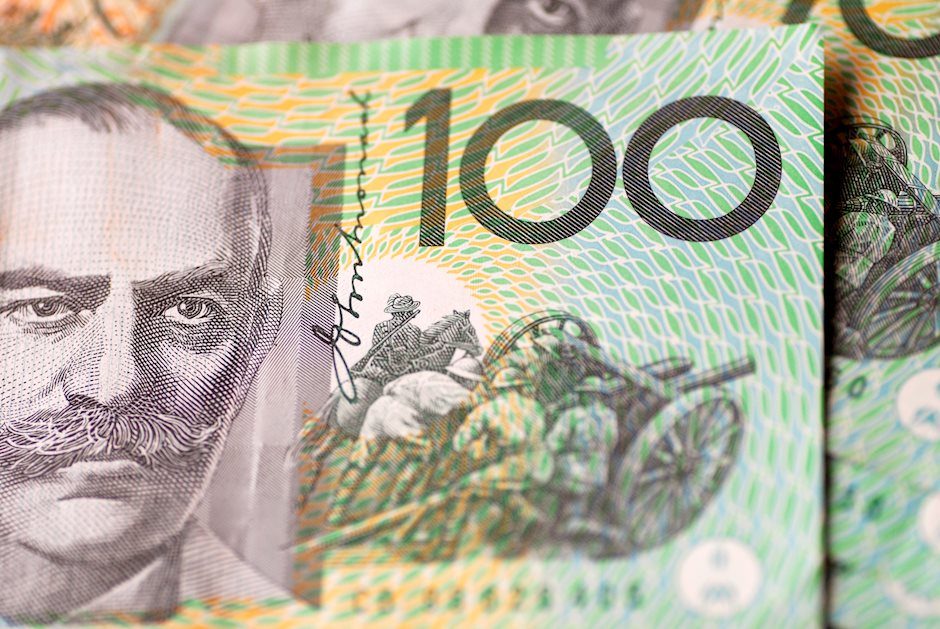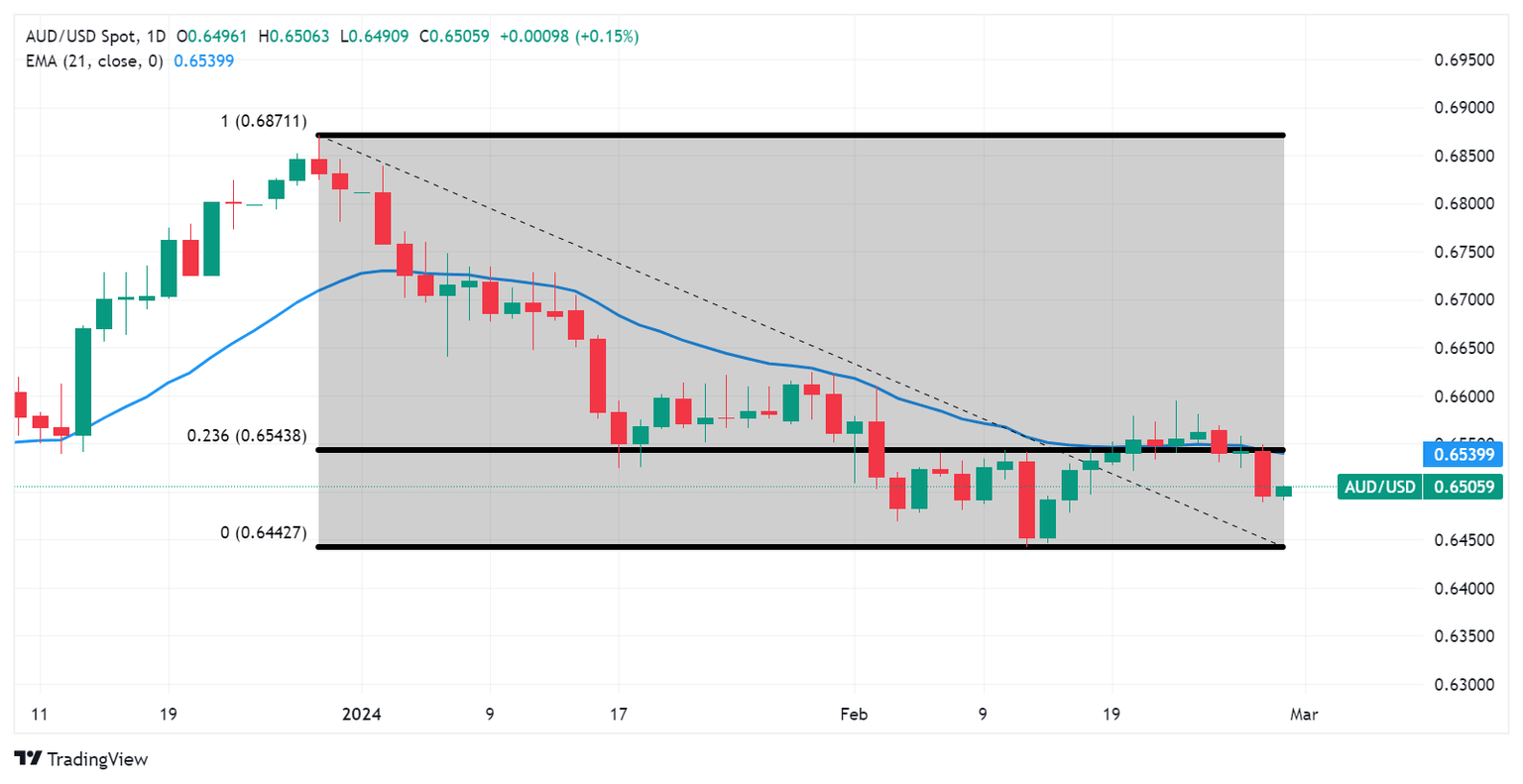Australian Dollar gains ground amid a stable US Dollar ahead of US PCE - Price Index
- Australian Dollar gains ground after Australia’s consumer spending data on Thursday.
- Australian (MoM) grew by 1.1% in January, against the expected 1.5% and the previous decline of 2.7%.
- US Dollar Index (DXY) remains stable amid the higher US Treasury yields.
- US GDP Annualized (Q4) increased by 3.2%, slightly below market expectations of remaining steady at 3.3%.

The Australian Dollar (AUD) retraces its recent losses following the release of Australia’s Retail Sales and Private Capital Expenditure data on Thursday. However, recent Gross Domestic Product (GDP) data from the United States (US) has led financial markets to delay expectations for the Federal Reserve’s (Fed) first rate cut. This has provided some support for the US Dollar (USD), thereby weakening the AUD/USD pair.
Australian Dollar received upward support as the S&P/ASX 200 Index recovered daily losses. However, the Aussie equity market opened lower as gains in the property sector are being offset by losses in the tech sector on the final day of company reporting. Selling pressure was further intensified by Wednesday's inflation data and weaker commodity prices. Additionally, Australian markets are taking cues from a weak performance on Wall Street overnight as traders exercise caution ahead of the release of key US Personal Consumption Expenditures - Price Index data, which could potentially influence the Federal Reserve's monetary policy stance.
The US Dollar Index (DXY) maintains its stability amid higher US Treasury yields. Furthermore, US Federal Reserve speakers have maintained a cautious stance, suggesting potential rate cuts later in the year. This leads to a reduced likelihood of rate cuts in upcoming meetings, providing upward support for the Greenback.
Daily Digest Market Movers: Australian Dollar improves after Retail Sales data
- The seasonally adjusted Australian Retail Sales (MoM) grew by 1.1% in January, lower than expected 1.5% but swinging from the previous decline of 2.7%.
- Australian Private Capital Expenditure improved by 0.8% in the fourth quarter of 2023, from the expected 0.5% and 0.6% prior.
- Australian Monthly Consumer Price Index (CPI) was unchanged at 3.4% for January, which was below market expectations of 3.5%.
- Australian Construction Work Done increased by 0.7% in the fourth quarter of 2023, against the expected 0.8% and 1.3% prior.
- ANZ-Roy Morgan Australian Consumer Confidence is nearly unchanged at 83.2 for the current week. This marks the 56th consecutive week that the index has remained below the threshold of 85. The index sits just 0.4 points below the 2024 weekly average of 83.6.
- The Reserve Bank of New Zealand (RBNZ) decided to hold the Official Cash Rate (OCR) unchanged at 5.5%, as widely expected in its February monetary policy meeting.
- New York Federal Reserve (Fed) President John Williams stated on Wednesday that while there remains some ground to cover in reaching the Fed's 2% inflation target, the possibility of interest rate cuts this year is on the table, contingent upon incoming data.
- Boston Federal Reserve (Fed) President Susan Collins maintains her expectation for the Fed to initiate easing later this year. However, she notes that progress on inflation has decelerated, and policymakers should await further evidence to ensure a clear path toward the 2% target.
- As per the CME FedWatch Tool, the odds for March rate cuts is 3.0%, with the likelihood of a cut down in May and June to 19.3% and 52.6%, respectively.
- According to reports, US House Speaker James Michael Johnson has informed the White House of his willingness to adjust the two funding deadlines to March 8 and March 22. Currently, funding is set to expire for four bills on March 1, and for eight bills on March 8.
- The preliminary US Gross Domestic Product Annualized grew by 3.2% in the fourth quarter of 2023, slightly below market expectations of remaining steady at 3.3%.
- The preliminary US Gross Domestic Product Price Index (Q4) increased by 1.7% against the expected and previous rise of 1.5%.
- US Housing Price Index (MoM) increased by 0.1% in December, falling short of the 0.3% expected and 0.4% prior.
- US Durable Goods Orders decreased by 6.1% against the market expectation of a 4.5% decrease and a previous decrease of 0.3%.
- US New Home Sales Change (MoM) grew by 1.5% in January, falling short of the previous growth of 7.2%.
- US New Home Sales (MoM) came in at 0.661M in January against the expected 0.680M and 0.664 prior.
Technical Analysis: Australian Dollar hovers around the psychological level of 0.6500
The Australian Dollar traded around the psychological level of 0.6500 on Thursday. A breach below this level could potentially prompt the AUD/USD pair to target the area around the major support level of 0.6450 and February’s low at 0.6442. Conversely, on the upside, the immediate resistance zone is observed around the 21-day Exponential Moving Average (EMA) at 0.6539, followed by the 23.6% Fibonacci retracement at 0.6543 and the major level of 0.6550. A breakout above this resistance zone may lead the AUD/USD pair to approach the psychological level of 0.6600.
AUD/USD: Daily Chart
Australian Dollar price today
The table below shows the percentage change of Australian Dollar (AUD) against listed major currencies today. Australian Dollar was the strongest against the Euro.
| USD | EUR | GBP | CAD | AUD | JPY | NZD | CHF | |
| USD | 0.02% | -0.06% | -0.05% | -0.37% | -0.55% | -0.14% | -0.03% | |
| EUR | -0.03% | -0.08% | -0.07% | -0.39% | -0.57% | -0.16% | -0.05% | |
| GBP | 0.06% | 0.08% | 0.01% | -0.31% | -0.49% | -0.07% | 0.04% | |
| CAD | 0.05% | 0.09% | -0.01% | -0.32% | -0.50% | -0.08% | 0.03% | |
| AUD | 0.37% | 0.39% | 0.30% | 0.32% | -0.18% | 0.24% | 0.33% | |
| JPY | 0.54% | 0.57% | 0.48% | 0.48% | 0.17% | 0.43% | 0.52% | |
| NZD | 0.13% | 0.16% | 0.08% | 0.10% | -0.23% | -0.41% | 0.13% | |
| CHF | 0.03% | 0.06% | -0.04% | -0.03% | -0.35% | -0.53% | -0.11% |
The heat map shows percentage changes of major currencies against each other. The base currency is picked from the left column, while the quote currency is picked from the top row. For example, if you pick the Euro from the left column and move along the horizontal line to the Japanese Yen, the percentage change displayed in the box will represent EUR (base)/JPY (quote).
Australian Dollar FAQs
What key factors drive the Australian Dollar?
One of the most significant factors for the Australian Dollar (AUD) is the level of interest rates set by the Reserve Bank of Australia (RBA). Because Australia is a resource-rich country another key driver is the price of its biggest export, Iron Ore. The health of the Chinese economy, its largest trading partner, is a factor, as well as inflation in Australia, its growth rate and Trade Balance. Market sentiment – whether investors are taking on more risky assets (risk-on) or seeking safe-havens (risk-off) – is also a factor, with risk-on positive for AUD.
How do the decisions of the Reserve Bank of Australia impact the Australian Dollar?
The Reserve Bank of Australia (RBA) influences the Australian Dollar (AUD) by setting the level of interest rates that Australian banks can lend to each other. This influences the level of interest rates in the economy as a whole. The main goal of the RBA is to maintain a stable inflation rate of 2-3% by adjusting interest rates up or down. Relatively high interest rates compared to other major central banks support the AUD, and the opposite for relatively low. The RBA can also use quantitative easing and tightening to influence credit conditions, with the former AUD-negative and the latter AUD-positive.
How does the health of the Chinese Economy impact the Australian Dollar?
China is Australia’s largest trading partner so the health of the Chinese economy is a major influence on the value of the Australian Dollar (AUD). When the Chinese economy is doing well it purchases more raw materials, goods and services from Australia, lifting demand for the AUD, and pushing up its value. The opposite is the case when the Chinese economy is not growing as fast as expected. Positive or negative surprises in Chinese growth data, therefore, often have a direct impact on the Australian Dollar and its pairs.
How does the price of Iron Ore impact the Australian Dollar?
Iron Ore is Australia’s largest export, accounting for $118 billion a year according to data from 2021, with China as its primary destination. The price of Iron Ore, therefore, can be a driver of the Australian Dollar. Generally, if the price of Iron Ore rises, AUD also goes up, as aggregate demand for the currency increases. The opposite is the case if the price of Iron Ore falls. Higher Iron Ore prices also tend to result in a greater likelihood of a positive Trade Balance for Australia, which is also positive of the AUD.
How does the Trade Balance impact the Australian Dollar?
The Trade Balance, which is the difference between what a country earns from its exports versus what it pays for its imports, is another factor that can influence the value of the Australian Dollar. If Australia produces highly sought after exports, then its currency will gain in value purely from the surplus demand created from foreign buyers seeking to purchase its exports versus what it spends to purchase imports. Therefore, a positive net Trade Balance strengthens the AUD, with the opposite effect if the Trade Balance is negative.
Author

Akhtar Faruqui
FXStreet
Akhtar Faruqui is a Forex Analyst based in New Delhi, India. With a keen eye for market trends and a passion for dissecting complex financial dynamics, he is dedicated to delivering accurate and insightful Forex news and analysis.


















